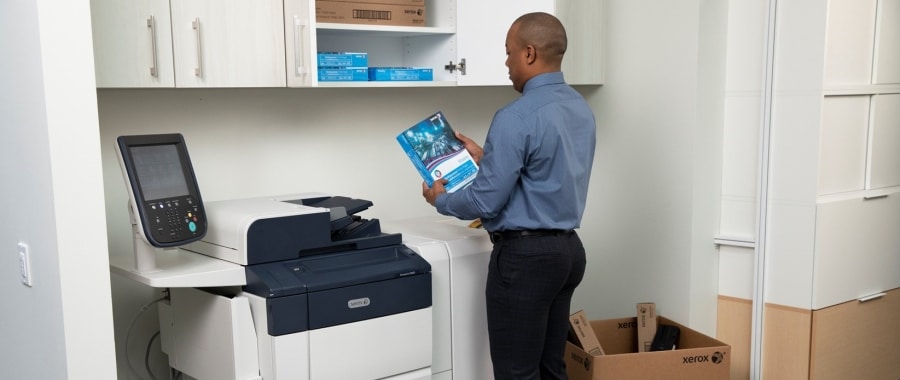We are happy that it’s summertime with all the joys that brings. It also brings heat and humidity, at times at very high levels. Many people enjoy the heat and look forward to it as they plan for time on the beach. Even high humidity doesn’t deter some folks. That’s not the case for printer paper when it is being stored. High humidity can have a negative effect on paper that will impair your ability to get good prints.
Paper Storage Explained:
Paper is highly sensitive to moisture and the humidity levels within which it is stored. When paper is manufactured, most manufacturers produce paper to strict quality standards including a well-regulated level of humidity of between 25-50%. The paper is then carefully sealed into packaging that contains a special lining for maintaining the humidity level of the paper for as long as it is properly stored. It is then loaded into cases and onto wooden pallets with an even surface for shipping to the customer. Paper shipped in this condition is perfect for xerographic applications, but the freshness of the paper is dependent upon the conditions when stored, waiting to be used.
As paper is made of wood fibers, it exhibits similar behavior as other paper products such as paper towels. As a result, paper that is improperly handled or stored, can be subject to excess moisture from the atmosphere, which can cause the paper to increase in size, warp, curl or stick together.
Paper Storage Issues:
Paper with moisture issues can lead to the following issues:
- Damp paper can warp in tray – Paper that has absorbed too much moisture from the atmosphere can begin to become wavy or warp, starting around the edges of the sheet. Warped paper can jam in the paper tray when attempting to feed from the tray, causing a misfeed, and cause wrinkles during the printing process.
- Dry paper can also warp in tray – Paper that has lost too much moisture can contract around the edges of the sheet causing “tight edges”, which can lead to misfeeds, jams, registration issues as well as wrinkles.
- Damp paper can wrinkle in the paper path – Slightly deformed damp paper can lead to paper wrinkling in the paper path. This can result in wrinkled output, paper jams and lines in prints.
- Damp paper can affect toner bonding to paper – Damp paper can lead to poor toner application to paper and poor fusing, such as light/faded output, smudging or toner rubbing off the page.
- Damp paper may curl – Damp paper may curl more than normal paper would, resulting in curly paper output, or increased instances of misfeeds and paper jams.
- Damp paper may adhere to other sheets – Damp paper may stick to neighboring sheets of paper, becoming difficult to separate and cause misfeeds and jams when multiple sheets of paper are pulled into the printer at once.
Paper Storage Considerations:
Please read this knowledge article which includes paper storage guidelines for the AltaLink C8030/ C8035/ C8045/ C8055/ C8070 printer family and EC8036/ EC8056 multifunction printers:
For all product models:
- Keep paper in its original packaging until ready for use – Paper is packaged in a wrapper lined with polyethylene plastic that is resistant to moisture and maintains the moisture level of the paper inside the package. Also, keep unopened packages of paper stored inside their original cardboard carton whenever possible. Reseal the package if using only a portion of it.
- Do not store paper on or near the floor – Keep the paper away from environments that experience extreme temperature and humidity shifts. Do not store paper flat on the floor as this increases chances of moisture being absorbed into the paper.
- Store paper in a storage cabinet or flat shelf – For paper storage, always keep unused paper in a dry, flat storage cabinet where it can be protected from physical damage and the elements. Always stack the paper evenly on top of the other to avoid curling, bending or damage to the corners of the paper.
- The storage location should be climate controlled – The storage location should also be kept within 68°F/20°C to 76°F/24.4°C and within 35-55% humidity levels for best results. In damp or humid environments, paper, even the paper already loaded into the paper trays, can absorb moisture from the air and become too damp to use.
- Paper must be conditioned before use – If the paper cannot be stored in a climate controlled environment or has not been stored this way, the paper must be given a conditioning period before use in accordance to the temperature and humidity levels at which it was stored. For example, a carton of paper stored in a 57.2°F/14°C storage room, brought into a 72.5°F/22.5°C production room must be conditioned for 8 hours before use for best results.
- Use only the amount of paper needed in the tray – When loading paper into the printer, load only the amount of paper that the job requires or that will be used in the short term. Paper inserted into the paper trays will absorb moisture from the atmosphere over time, which can lead to the many damp paper issues listed above.
If you experience one or more of the symptoms described above – paper curling, jamming, paper sticking together – the answer just may be to remove the paper in the paper trays and replace it with a newly opened package of paper that has been properly stored. Humidity levels may have damaged the paper in the trays.
Enjoy the summer and the summer weather. And don’t let it ruin your prints!



